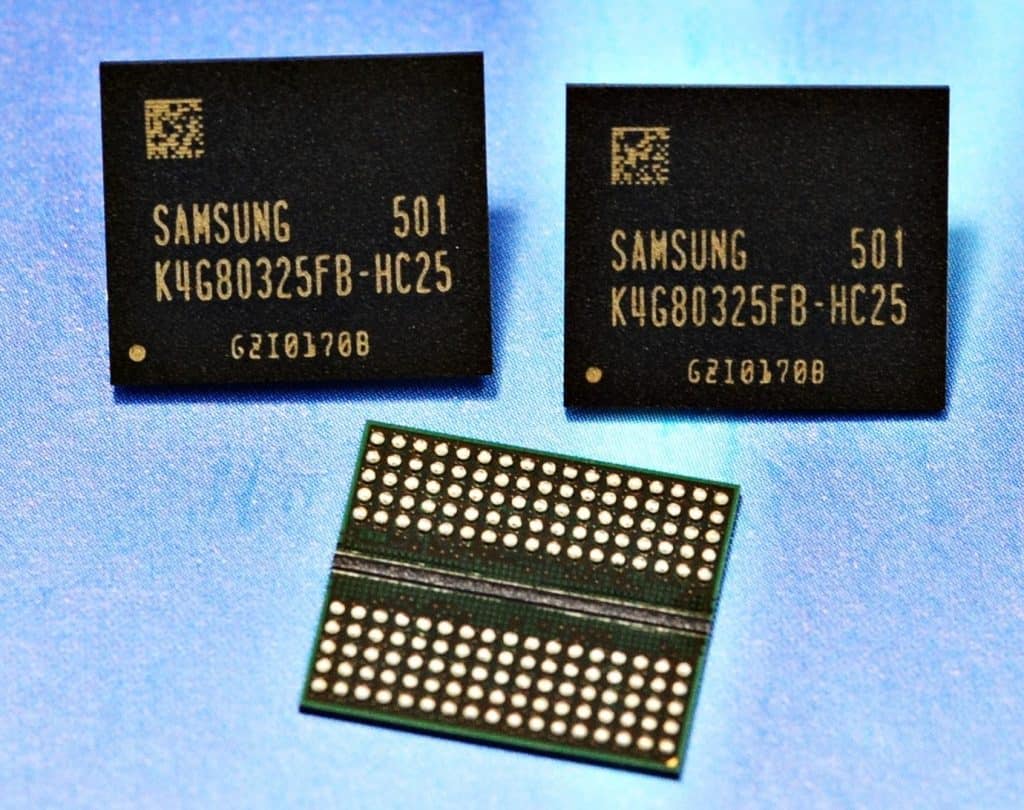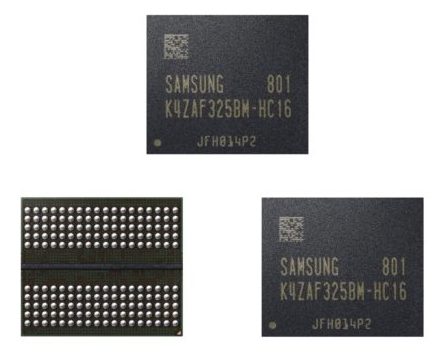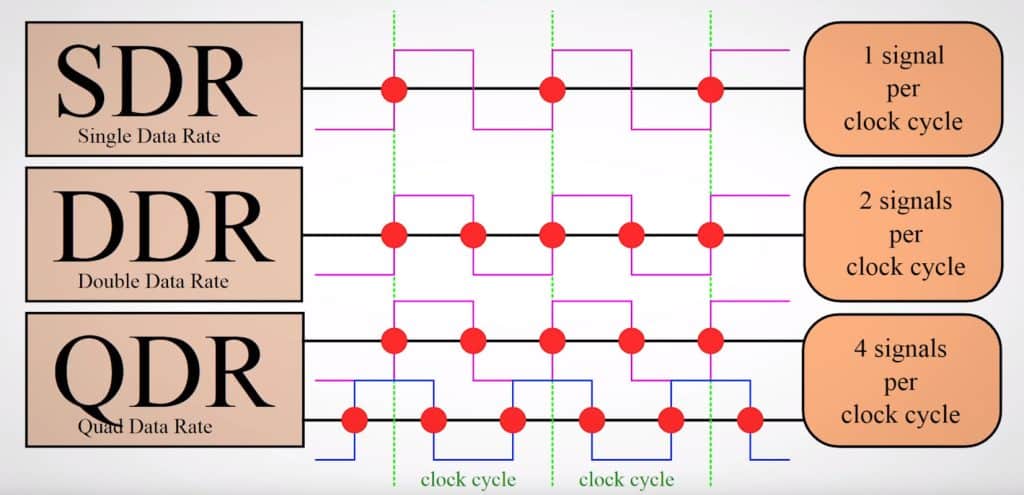The GDDR5 vs GDDR6 memory comparison is possible only if we take into consideration several significant factors. The most important things you need to consider when choosing between the two are memory speed, capacity, bus width, and power consumption. So, if you are unsure which of these components is better, let us guide you through their main features!


Whether you want to buy GDDR5, GDDR5X, GDDR6, or even HBM2, you need to pay attention to the memory capacity and bus width. A larger capacity doesn’t guarantee higher performance. When it comes to gddr5 vs gddr6, it is better to choose GDDR6 – 256 bits and 1 GB capacity than GDDR5 – 128 bits and 2 GB capacity.
GDDR5 SDRAM vs GDDR6 SDRAM
Base Speed
The base clock speed shows how fast the memory can process the data. It is measured in MHz. However, the base clock speed depends on several factors. One of the most important factors is the bus width. The bus width represents the amount of data that can be transmitted at a time.
For instance, you can have a memory with a bus width of 256 bits and a base speed of 1,000 MHz. This means the memory can execute 1,000 clock cycles in 1 second, transmitting 256 bits of information per cycle (1,000×256 = 256,000 bits/s).
Another example shows a memory that operates at a frequency of 1,800 MHz but has a 128-bit bus (1,800×128 = 230,400 bit/s).
To conclude, the example above shows us how important the bus width is when compared to frequency. In other words, a significantly higher frequency can be less productive due to a narrow bus width.
Clock Speed (Effective Memory Speed)
Among other things, when buying a graphics card, you should pay attention to the clock speed or effective memory. It is expressed in Gbps (Gigabits per second). Manufacturers prefer to use gigabits instead of megahertz to indicate graphics card memory speeds.
The GDDR5 is DDR which means Double Data Rate. Data rate signifies how much data is being sent per clock cycle. It can be one signal, two signals, four signals, and so on. From that point of view, we have SDR, DDR, and QDR.

The picture above illustrates signals marked by red dots and clock cycles. You can also notice the pink lines which mark the rise and fall of the signal.
However, the clock speed or effective speed can transfer more than one signal per cycle. So, since the GDDR5 is based on DDR, to calculate the effective memory speed, we should use the following formula:
Base memory speed x 2 (rise and fall) x 2 (two signals) = effective memory speed
On the other hand, the GGDR6 memory is QDR or Quad Data Rate. This means it can send four signals per clock cycle. With that in mind, the formula for the GGDR6 effective memory speed is:
Base memory speed x 2 (rise and fall) x 4 (four signals) = effective memory speed
Boost Speed
It is always recommended to use the default clock speed set by the manufacturer. However, if you need to increase your graphics card speed, you can increase the clock speed. You will get a new speed called the boost speed.
Overclocking means pushing the performance of your graphics card above its factory limits. With that in mind, you should be careful because there are some side effects such as increased power, overheating, or damaged internal computer components.
Still, if you decide to boost your memory clock speed, make sure you use the proper tools such as MSI Afterburner or EVGA Precision X1. Increase memory speed gradually and monitor the performance and temperature.
If your computer freezes or reboots, you have reached your limit. It’s recommended to lower the speed to around 20 Mhz below the limit. Be careful, and don’t let your graphics card die. Here are 4 signs that your graphics card is dying.
Performance
You also need to pay attention to the bus width and memory capacity when it comes to performance. This can affect your graphics card performance but only to a certain extent.
In many cases, it is a better choice to buy a graphics card with the GDDR6 memory – 256 bits and 1 GB capacity than a card with the GDDR5 memory – 128 bits and 2 GB capacity.
Low-bandwidth cards are usually designed for inexperienced customers. So, when choosing a graphics card, you should pay attention to the bus width instead of the memory size. The higher the number, the better.
Gaming Speed
Few people think about how complicated it is to process different graphic data into the final image displayed on the monitor. That is the primary job of a GPU. The GPU is a processor that calculates and generates graphical information displayed on a monitor. This is especially important when it comes to video games.
If you want to experience more fluidity in games, you need to pay attention to RAM and video memory. Although system memory is not a part of the graphics card, you need to know how much RAM you need on your device.
Another crucial factor is video memory (VRAM). It can significantly affect the gaming speed. However, many people don’t pay attention to whether their new graphics cards have the GDDR5 or GDDR6 memory.
Since capacity is essential for the RAM, people assume the same for the VRAM. Manufacturers use this opportunity and offer models such as 1 GB of GDDR6 or 2 GB of GDDR5 memory. In many cases, people choose the second option since the capacity label is large and the type of memory is small. But for VRAM, capacity should not be the only deciding factor.
It is worth mentioning that each subsequent generation memory is better than the previous one and enables work at higher frequencies. However, even if you choose to invest in the latest memory generation graphics card with low bandwidth, you may not achieve maximum performance, especially in games.
If you want to buy a gaming card, read the specifications carefully and pay special attention to the type of memory and the bus width. It is always recommended to buy a graphics card with the latest generation memory (in this case, the GDDR6) with a wide memory bus and a specific capacity.
GDDR5 vs GDDR6 – Quick Comparison
| GDDR5 | GDDR6 | |
|---|---|---|
| Manufacturer | Samsung, Micron, and Hynix | Samsung, Micron, and Hynix |
| Transfer Speeds | 8 Gbps | 14 Gbps to 16 Gbps |
| I/O Configuration | X16/x32 | X8/x16 |
| Channel Count | 1 | 2 |
| Memory Capacity | 512 MB, 1 GB, 2 GB, 4 GB, 8 GB | 8 GB and 16 GB |
| Power Consumption | Higher – 1.5 V | Lower – 1.35 V (1.25 V at reduced data rates) |
| Availability | FBGA190, 0.65 mm pitch, 14x10mm | FBGA180, 0.75 mm pitch, 14×12 mm |
The GDDR5 is still relevant on the market, even though there are improved versions – the GDDR5X and GDDR6. But the GDDR6 has some rather significant improvements when compared to GDDR5.
Even though the power consumption is low on both, the newer version uses around 10% less power. The GDDR5 uses 1.5V, and the GDDR6 uses 1.35V or 1.25V at reduced data rates. As expected, the GDDR6 offers higher transfer speeds – 14 Gbps to 16 Gbps, while the GDDR5 has speeds of up to 8 Gbps.
The GDDR5 has X16/x32 I/O configuration and one channel, while the GDDR6 offers X8/x16 and two channels. When it comes to size options, the GDDR5 has more options, but the biggest size is 8GB, while the GDDR6 comes in 16GB.
The most significant differences between these two memories come down to transfer speed. Other specs are either equal or similar.
What does GDDR Stand For?
GDDR stands for Graphics Double Data Rate. The full name is GDDR SDRAM. SDRAM stands for Synchronous Dynamic Random-Access Memory. What this memory does is – reduce the latency or the delay when your graphic card processes the commands. It does that by synchronizing data input and output on the clock edges.
GGDR5
Pros:
- Affordable
- Lots of memory capacity sizes
- Fairly good transfer speed
- Great choice if you have an older GPU
Cons:
- Technology over 10 years old
- Lower transfer speed when compared to GDDR6
GGDR6
Pros:
- High transfer speed
- A great choice for gaming
- Low power consumption
- Large capacities
Cons:
- Significantly more expensive than GDDR5
Graphics Cards with GDDR5 Memory
NVIDIA
- GTX Titan
- GeForce GTX 980 Ti
- GeForce GTX 1070 [Ti]
- GeForce GTX 1050 Ti
- GeForce GTX 1060 6GB
AMD
- Radeon RX 480
- Radeon RX 580
- Radeon RX 590
- Radeon HD 7990
- Radeon R9 295X2
Graphics Cards with GDDR6 Memory
NVIDIA
- Titan RTX
- GeForce RTX 2080 [Ti]
- GeForce RTX 3060 [Ti]
- GeForce RTX 3070
- GeForce RTX 2070 Super
AMD
- Radeon RX 6900 XT
- Radeon RX 6800 XT
- Radeon RX 6700 [XT]
- Radeon RX 5700 [XT]
- Radeon RX 5600 XT
Frequently Asked Questions
Is GDDR6 better than GDDR5?
Yes. The GDDR6 is a better and improved version of the GDDR5. The GDDR5 memory still has its place, but the newer versions, the GDDR5X and the GDDR6, are pushing it aside. The main reason is that it will soon become outdated mainly due to the slower transfer speed.
Can I replace GDDR5 with GDDR6?
An average user should not replace the GDDR5 on their own. The GDDR5 is not manufactured as a memory stick that you can easily remove or install. The replacement requires technical knowledge. Therefore, it is recommended to leave it to the professionals.
Is GDDR6 good for gaming?
Yes. If you need a GDDR for gaming purposes, the GDDR6 is the best choice. The HBM2, the GDDR6’s biggest competition, is superior when it comes to AI simulations and video editing. But when it comes to gaming, the GDDR6 is superior to the HBM2.
Conclusion
The GDDR6 is the best choice for gaming and also for artificial intelligence, cryptocurrency mining, and virtual reality. On the other hand, the GDDR5 still offers good speed and performance at more affordable prices.
However, without any doubt, the future graphics cards will come with the GDDR6. So, slowly, the GDDR6 will become predominant in the market. With almost double the speed and double the size, the GDDR6 will leave the GDDR5 behind.
This doesn’t come as a surprise since GDDR5 has been around for over 10 years, whereas GDDR6 has been on the market since 2019.
To conclude, in this GDDR5 vs GDDR6 memory comparison we need to point out several things. When deciding between these two components, first check the bus width. The higher the number the better. Next, check out the memory speed and the type of memory. Finally, make sure your new graphics card has enough memory capacity.